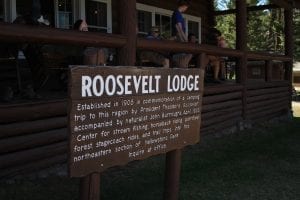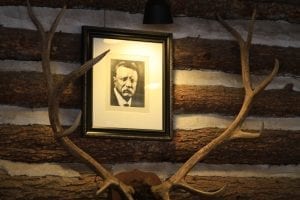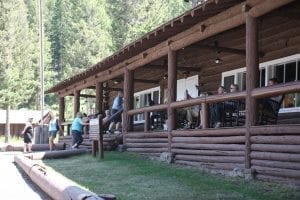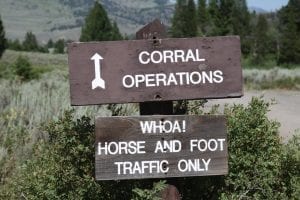 In September of 2010 Roosevelt Lodge in Yellowstone National Park celebrated it’s 90th anniversary and in 2020 this historic lodge will be a hundred years old.
In September of 2010 Roosevelt Lodge in Yellowstone National Park celebrated it’s 90th anniversary and in 2020 this historic lodge will be a hundred years old.
It is located in the scenic northern region of the park and is the smallest of the nine park lodges. It has 80 cabins, some of which date back to the 1920s and also has a main lodge building where the dining area, registration, lobby and gift shop are located. It was built in an area of the park that was a favorite of Theodore Roosevelt, although Roosevelt never stayed at the lodge as it was built 17 years after his visit. He did spend a couple of nights camping in the area exploring, fishing and watching the wildlife.
 So – how did Roosevelt Lodge come into existence? This area of the park was favored by explorers on expeditions to discover the wonders of this part of what was to become Yellowstone National Park. Mountain men, trappers, Indians and prospectors traveled thru the area on their way to Lamar Valley, the Lamar River or Soda Butte Creek either seeking game to trap or looking for gold.
So – how did Roosevelt Lodge come into existence? This area of the park was favored by explorers on expeditions to discover the wonders of this part of what was to become Yellowstone National Park. Mountain men, trappers, Indians and prospectors traveled thru the area on their way to Lamar Valley, the Lamar River or Soda Butte Creek either seeking game to trap or looking for gold.
It was “Uncle” John Yancey who was a squatter in this region until 1882 when he was granted a concession to operate the mail station at his Pleasant Valley Ranch. (The site of the Roosevelt Lodge cookout of modern day is located on the site of what was the Pleasant Valley Ranch.) Yancey also operated a saloon and served whiskey in glasses that he claimed had “never been profaned by contact with water.” Yancey died in 1903 and his nephew, Dan, assumed operation of the enterprise. It is reported that Dan did not have the flair for hospitality that his late uncle had and the ranch did not fare too well financially under his leadership. The lodge burned to the ground in 1906 and was never rebuilt.
In the early 1900s the Wylie Permanent Camping Company appeared on the Yellowstone scene and started a series of tent camps including Camp Roosevelt. Their target market was those visitors who wanted to experience Yellowstone but could not afford the Grand Tour hotels such as the Inn At Old Faithful. Camp Roosevelt was located very near the site of today’s Roosevelt Lodge. The accommodations were wood-floored tents with basic furniture and there was a single large tent used for dining.
Camp Roosevelt also provided evening entertainment for their guests. The camp staff would perform skits and there would frequently be sing-alongs held around the campfire. These performances were by no means professional but did provide an opportunity for the guests to gather around the fire and get to know one another. It provided something that was closely akin to a family atmosphere for the campers. Park rangers began giving interpretive talks around the fire and this eventually replaced the staff entertainment.
One of the amenities provided the campers was that early every morning a staff worker would quietly enter the tents and build a fire in the wood stove so the campers would wake up to a warm tent. Another duty of the staffers was to be at the dining tent armed with bats and shovels to ward off the bears when they visited the dining tent looking for an easy dinner.
 The construction of the present day Lodge was completed in September of 1920. It included a dining room which featured a stone fireplace, lobby and registration area. It also featured a wide porch with Old Hickory rocking chairs for the convenience and comfort of the guests. An original photograph of Teddy Roosevelt hung on the lobby wall. No one knows for sure how many cabins were originally constructed but it is well known that some cabins were moved to Roosevelt from other locations within the park.
The construction of the present day Lodge was completed in September of 1920. It included a dining room which featured a stone fireplace, lobby and registration area. It also featured a wide porch with Old Hickory rocking chairs for the convenience and comfort of the guests. An original photograph of Teddy Roosevelt hung on the lobby wall. No one knows for sure how many cabins were originally constructed but it is well known that some cabins were moved to Roosevelt from other locations within the park.
Today it includes 14 Frontier Cabins with two double beds, a bathroom with shower, toilet and sink. The 66 Roughrider cabins are more simply furnished having a bed and a wood stove. Roughrider guests use the shared public bathrooms that are located nearby.
 The property also includes a corral that houses the horses for the trail rides and wagon rides in the park. It is also the staging area for the Old West Cookout which offers a western-style buffet with steaks, Roosevelt style baked beans, corn muffins and more. There are songs and story-telling around the campfire. You may either take the horse-drawn wagon or, if you prefer, you may decide a trail ride is more to your liking to get you to your destination. You will not leave hungry. Just remember, if you decide to do the horseback ride to the cookout you will also have to ride that horse back to the corral! Do not delay in making your reservations if the western cookout is something that sounds intriguing to you. The spots fill quickly.
The property also includes a corral that houses the horses for the trail rides and wagon rides in the park. It is also the staging area for the Old West Cookout which offers a western-style buffet with steaks, Roosevelt style baked beans, corn muffins and more. There are songs and story-telling around the campfire. You may either take the horse-drawn wagon or, if you prefer, you may decide a trail ride is more to your liking to get you to your destination. You will not leave hungry. Just remember, if you decide to do the horseback ride to the cookout you will also have to ride that horse back to the corral! Do not delay in making your reservations if the western cookout is something that sounds intriguing to you. The spots fill quickly.
Today the Lodge has the shortest season of any of the park’s lodges usually opening in early June and closing for the season in early September.
The Lodge is also home base for the Lodging & Learning program called the Roosevelt Rendezvous. This award winning program is a partnership between Xanterra Parks & Resorts and the non-profit Yellowstone Association Institute. This is a four-night program that includes accommodations at the lodge, all meals, a welcome gift and in-park transportation for the daily field trips to explore the geology, wildlife and human history of the park. This program is usually held in September once the Lodge has closed for the season.
You will not be disappointed in this area of the park. If you decide to spend a few nights at the Lodge make your reservations early. If you are not planning on staying at the Lodge I would encourage you to include this part of the park on your visit. The scenery is amazing and you will be glad that you took the time to visit here.
Photos courtesy of Yellowstone National Park.
AUTHOR: SUE KNAPP